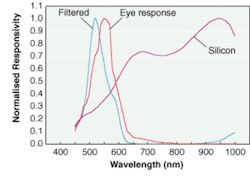The concept of light pollution generated by excess or stray illumination from light-emitting devices is not a new one. But the proliferation of handheld devices that require artificial illumination for viewing—such as mobile phones and personal digital assistants (PDAs)—has led to the development of a control strategy that may eventually help, among other things, to reduce unwanted and wasted light.
Engineers at Agilent (Palo Alto, CA) have developed an ambient-light sensor that is already being designed into cell-phone systems and that is slated for full-scale production by the end of this year. Originally intended to extend battery life in handheld devices, the ambient-light sensor prevents backlighting from turning on when ambient light is bright enough for unassisted viewing. The sensor is expected to cut power consumption by about two-thirds. The device can also adjust the level of backlighting in a cell phone, personal digital assistant (PDA), or laptop computer screen to complement varying levels of ambient lighting—for instance, setting one illumination level at dusk and another in total darkness.
"Think of walking down the aisle of a plane at night. Everybody has got their laptops out and practically the whole cabin is illuminated with laptop screens burning brightly," said Bruce Felch, Americas marketing manager for Agilent's Infrared Products Operation. "Laptops typically have a button allowing you to dim the display light, but a lot of people don't use it. It would be great to have a device like this in a laptop that allows the backlighting of a display to be automatically adjusted."
Of course the trick in making automatic illumination adjustments is to make them accurately, so that the user of the cell phone, PDA, or laptop experiences the result as a convenience rather than an annoyance. The key to doing this in the ambient-light sensor is a filtering system that shifts the photodiode spectral sensitivity from the infrared region that is characteristic of most light-emitters to the visual spectral sensitivity of the human eye (see figure).
"Using a phototransistor as your ambient-light detection system, you could have a light source that is emitting lots of light in the 900-nm range but not so much in the 550-nm range," Felch said. "Your eye says, 'Hey, it's dark, we need the backlight.' But the phototransistor says, 'Hey, I'm seeing lots of light. I don't need to turn on the backlight.' So you get an accuracy issue."
In addition to turning the backlighting on or off, integrated circuitry on the ambient-light sensor allows a designer to set three additional thresholds, either hard-wired to preset levels or adjustable to environmental conditions through the onboard processor in the cell phone, PDA, or laptop.
Currently, Agilent has shipped the ambient-light sensor in prototype volumes to OEM customers who hope to have it designed into cell phones and PDAs as a battery-saving device by the end of this year. Cell-phone displays and keypads draw anywhere from 100 to 400 mA of current and are lit unnecessarily about 60% or 70% of the time, according to Felch. The light sensor could keep the light off when not needed, while only drawing 10 nA of current when ambient light is below the turn-on threshold and 30 µA above threshold.
Beyond cell phones, PDAs, and laptops, Agilent is also targeting the ambient-light sensor to extend battery life in other devices, such as camcorders, digital cameras, MP3 players, and personal DVD players. But battery-powered devices represent only one of the potential application categories, Felch said. Discussions with manufacturers seem to have indicated a totally different and perhaps much larger one.
"The other potential category that was not originally anticipated includes devices that don't have battery current drives necessarily, but that do have brightness and contrast concerns," he said. "One of them is home lighting, another is in the automotive dashboard. You can automatically dim or brighten dashboard lighting or home lighting based on the amount of light that is available. We've also had some preliminary talks with high-definition-TV manufacturers. When you locate your TV next to a window, if the sun is shining in brightly on it, you'd have problems with the brightness and contrast. So this sensor could allow for automatic adjustment and control."
